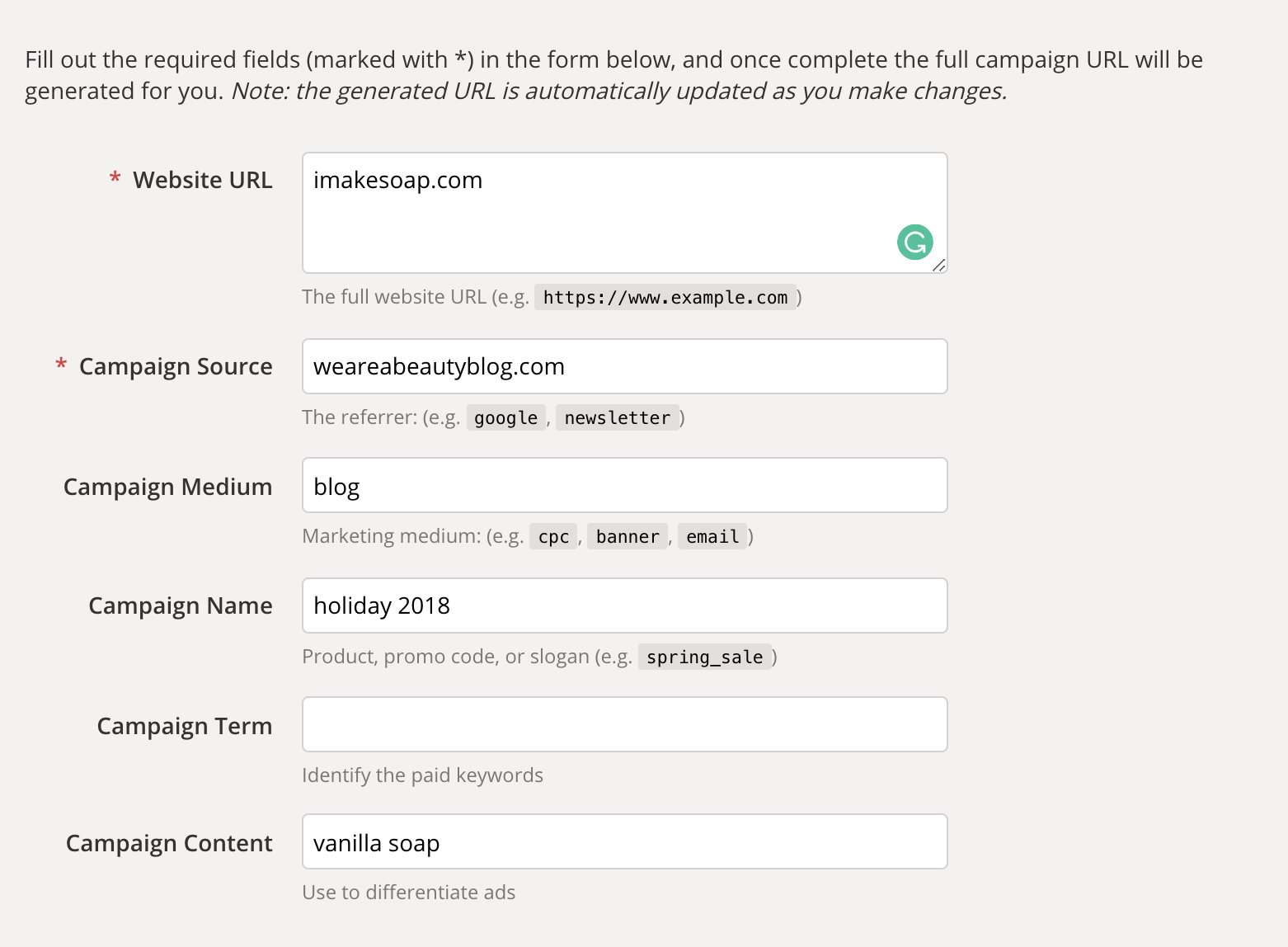UTM Codes are Essential for Your Content Marketing
Are you a business that is aiming to optimize performance, lower cost, and increase profit? If you answered “Yes!” to any of those questions and you have some or all of your business online, you should be using UTM codes. What’s a UTM code, you ask? It’s an Urchin Tracking Module, of course.
The purpose of UTM codes is to track what campaign is driving traffic. A UTM code is added to a URL and looks like this:
http://www.imakesoap.com?utm_source=weareabeautyblog&utm_medium=blog&utm_campaign=holiday%202018&utm_content=vanilla%20soap
UTM codes allow you track a source, medium, and campaign name. It helps you monitor marketing effectiveness and optimize accordingly. Even more, you can use UTM codes to track conversions in conjunction with goals in Google Analytics. All of this sounds great, but what does it mean?
Let’s say that I am a soap maker who is new to the market. I decide to invest some money into marketing on various blogs and social media channels. In order to figure out what is driving the most traffic and conversions, I am going to create a different UTM coded link for each channel and for each campaign. That means, for Instagram, I am going to have one link, for Facebook another and, for each beauty blog that is running a sponsored post, a unique UTM code for each. These will all show up in my Google Analytics so that I can tell whether it’s smarter for me to put ad dollars behind the Facebook page OR whether I am better off spending that money on sponsored blog posts with aligned brands. I’ll not only see which one is driving traffic, but which one is driving the most conversions!
How to Create UTM Codes
The nitty gritty of UTM codes is formulaic once you get used to it. You can do it manually if you know how the structure of a URL works. But, the easiest way to do it is to go to Google’s URL Builder. All you have to do is fill in the appropriate fields and it will generate a UTM coded link for you!

Let’s use the soap business as an example. For our soap company, we want to have the beauty blog “weareabeautyblog” publish about our soap for the holidays, and we want to track how well this campaign does.
The website URL field (this is required) is the site where I want to drive traffic to so I will plug in our company’s URL “http://www.imakesoap.com.” Be sure to put the full URL too.
The campaign source (this is required) is the place that is sending the traffic to our website imakesoap.com. In this instance, it would be the beauty blog that is promoting the soap, “weareabeautyblog.”
The campaign medium field (this is required) is the medium or channel where the link is going to be published. For our example, “weareabeautyblog.com,” the medium is “blog.” If the blog is also going to promote this across their social channels, I would want to send them UTM codes for each channel they planned to promote my soap on to get even more granular data, like Facebook, Instagram, etc.
The campaign name (this is required) is what it sounds like, a campaign name whether a promo code or however you keep track of campaigns at your company. For our example, let’s use “holiday 2018.”
The campaign term is where you can put paid keywords and lets you get really granular with your UTM code tracking. This isn’t a required field, but handy if you’re running AdWords.
The campaign content is used to differentiate ads. For our soap company, this can be something like “vanilla soap” or “lavender soap” if I am concentrating efforts on different products. This is great for A/B testing and content-targeted ads and is beneficial to know because you can tell what is resonating. You could also differentiate between locations in the “campaign content” field. Maybe you are marketing a very moisturizing soap to folks in cold climates, but for those in Florida, you want to sell an aloe soap that calms sunburn. All of this can be tracked! The campaign term can be used if you are doing paid campaigns – this is where you can plug in keywords, such as “moisturizing+soap.” This field isn’t essential though.
This is what the full UTM link looks like for the sponsored blog post for the links published on their blog:
http://www.imakesoap.com?utm_source=weareabeautyblog&utm_medium=blog&utm_campaign=holiday%202018&utm_content=vanilla%20soap
This is a lot to look at, to say the least.
UTM codes are just one piece of the puzzle for tracking too. They will tell you where traffic is coming from, but more tracking needs to be set up on the website to see what source is driving what type of conversions. This can be done with Google Analytics by setting up goals. Goals are easy to set up. Simply go into Google Analytics, visit the admin area for the website you want to set up a goal for, and then click “add goal.” Google will walk you through the rest in a few easy steps.
Best Practices
In conjunction with the UTM codes, we suggest creating custom bit.ly links when sharing the links on social media posts where the URL will be visible to readers. They look better and custom links can get up to 39% more clicks. As you know, the higher the click through rate, the better your SEO, so it’s key that each piece of the puzzle is properly executed. If you don’t already have a bit.ly account, you can create one for free. We use Google Sheets to set up our bit.ly naming conventions. Naming conventions make the formula easy to follow, customized links are more trustworthy, and the whole team can find what they need in Google Sheets.
For my soap company, my naming conventions might be something like this: bit.ly/companycampaignsourcecampaignmedium.
Where the company name is “imakesoap,” the campaign source is “beautyblog” and the campaign medium is correlated with the place the link is going to be published. For our example, Facebook is 1, Twitter is 2, Instagram is 3, Blog is 4.
If they were publishing the link on Facebook, the shortened UTM coded link would look like:
http://bit.ly/IMakeSoapBeautyBlog1.
If they were publishing the link on the blog, the shortened UTM coded link would look like:
http://bit.ly/IMakeSoapBeautyBlog4
A few things to keep in mind when creating UTM codes is that you cannot use quotes (“) in the URL and it’s generally best practice to use all lowercase letters. Use dashes instead of underscores ( _ ), percentages ( % ) and plus scores ( + ) because this makes the words more recognizable to browsers and search engines. Also, if each link isn’t exactly the same, they will track differently. At Sociality Squared, we keep link libraries in Google Sheets to help stay organized.
Once you are set up and tracking where website traffic is coming from, you can use the data to inform your decisions moving forward. You can hone in on ROI and really make the most of your marketing dollars.
If this sounds completely overwhelming, we get it. Sociality Squared is here to help you with this and more.
Resources:
URL Shortening: Mistakes to avoid and ways to make the most of your Links
Generic short URLs vs branded links, which has a better CTR?


